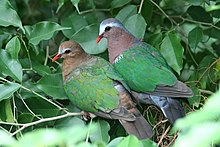Tat Mok National Park
| Tat Mok National Park | |
|---|---|
| อุทยานแห่งชาติตาดหมอก | |
 Near Tat Mok waterfall | |
| Location | Phetchabun Province, Thailand |
| Nearest city | Phetchabun |
| Coordinates | 16°28′5″N 101°23′25″E / 16.46806°N 101.39028°E |
| Area | 290 km2 (110 sq mi)[2] |
| Established | 30 October 1998[3] |
| Visitors | 17,872[4] (in 2019) |
| Governing body | Department of National Parks, Wildlife and Plant Conservation |
Tat Mok National Park (Thai: อุทยานแห่งชาติตาดหมอก, RTGS: Utthayan Haeng Chat Tat Mok) is a national park in Phetchabun Province, Thailand. Established on 30 October 1998, it is the 87th national park in Thailand. Both park and the waterfall are named after Tat Mok Mountains.[5]
Geography
[edit]Tat Mok National Park is about 37 kilometres (20 mi) east of Phetchabun in Mueang District.[6] The park's area covers 181,250 rai ~ 290 square kilometres (110 sq mi).[7]
The national park is abutting Phu Pha Daeng Wildlife Sanctuary and connected by Nam Nao National Park to the north, abutting Phu Khiao Wildlife Sanctuary to the east and abutting Tabo-Huai Yai Wildlife Sanctuary to the south. The park's streams and waterfalls provide the main source for the Pa Sak and Chi Rivers.[8]
History
[edit]In mid-1991 a survey was set up, a beautiful waterfall was found suitable for renovation into a tourist attraction. Later in 1995, the Royal Forest Department requested additional information so that the Tabo forest and Huai Yai forest area could become a national park. Tat Mok was declared the 87th National Park on 30 October 1998.[2] Since 2002 this national park has been managed by Protected Areas Regional Office 11 (Phitsanulok)
Flora
[edit]The park features forest types, including mixed deciduous, deciduous dipterocarp, dry evergreen and hill evergreen forest. Plants include:[9][10][11]
Fauna
[edit]In the park are the following mammals:[12]
The park has approximately 170 species of birds, of which some 110 species of passerine from 33 families, represented by one species:[12][13]
- Ashy woodswallow
- Asian fairy-bluebird
- Bar-winged flycatcher-shrike
- Black-naped monarch
- Black-naped oriole
- Blue-winged leafbird
- Brown shrike
- Common hill myna
- Common iora
- Crimson sunbird
- Dark-sided thrush
- Eared pitta
- Flavescent bulbul
- Greater racket-tailed drongo
- Grey-headed canary-flycatcher
- Indian white-eye
- Malaysian pied fantail
- Mekong wagtail
- Pale-legged leaf warbler
- Pin-striped tit-babbler
- Plain flowerpecker
- Plain prinia
- Racket-tailed treepie
- Rosy minivet
- Silver-breasted broadbill
- Streaked wren-babbler
- Striated swallow
- Tickell's blue flycatcher
- Velvet-fronted nuthatch
- White-bellied erpornis
- White-crested laughingthrush
- White-rumped munia
- Yellow-bellied warbler
and some 60 species of non-passerine from 19 families, represented by one species:[12][13]

- Asian emerald cuckoo
- Asian openbill
- Banded kingfisher
- Bay woodpecker
- Black-winged stilt
- Brown-backed needletail
- Chestnut-headed bee-eater
- Common emerald dove
- Eurasian hoopoe
- Great hornbill
- Green-eared barbet
- Indochinese roller
- Large-tailed nightjar
- Little egret
- Red-headed trogon
- Shikra
- Silver pheasant
- Vernal hanging parrot
- White-breasted waterhen
And reptiles:[12]
Places
[edit]- Namtok Tat Mok - a one level 200–300 metres (660–980 ft) high waterfall.
- Namtok Song Nang - a 12-tiered waterfall.[5][9]
Location
[edit]| Tat Mok National Park in overview PARO 11 (Phitsanulok) | ||||||||||||||||||||||||||||||||||||||||||||||||

|
See also
[edit]References
[edit]- ^ "Protected areas". UNEP-WCMC. 2020. Retrieved 4 October 2021.
- ^ a b "ตาดหมอก" [Tat Mok]. Department National Parks, Wildlife and Plant Conservation (in Thai). Retrieved 20 August 2021.
- ^ "พระราชกฤษฎีกา กำหนดบริเวณที่ดินป่าน้ำตะเบาะ และป่าห้วยใหญ่ ในท้องที่ตำบลห้วยใหญ่ ตำบลบ้านโคก และตำบลนาป่า อำเภอเมืองเพชรบูรณ์ จังหวัดเพชรบูรณ์ ใหเป็นอุทยานแห่งชาติ พ.ศ. ๒๕๔๑" [Royal Decree: Set the area of Tabo forest and Huai Yai forest in the area of Huai Yai subdistrict, Ban Khok subdistrict and Na Pa subdistrict, Mueang Phetchabun district, Phetchabun province to be a national park. B.E. 2541 (1998)] (PDF). Royal Thai Government Gazette. 115 (78 Kor): 11–13. 30 October 1998. Archived from the original (PDF) on May 28, 2014. Retrieved 30 December 2020.
- ^
"สถิตินักท่องเที่ยวที่เข้าไปในอุทยานแห่งชาติ ปีงบประมาณ พ.ศ.2562" [Statistics of tourists visiting National Parks fiscal year 2019]. Department of National parks, Wildlife and Plant Conservation (in Thai). 2019. Retrieved 16 February 2021, no.100 Tat Mok N.P.
{{cite web}}: CS1 maint: postscript (link) - ^ a b
"About Tat Mok National Park". GibbonWoot (managing company). 2021. Retrieved 30 July 2021, Thai National Parks website is NOT an official government website of the Department of National Parks. T.A.T. license 12/02497.
{{cite web}}: CS1 maint: postscript (link) - ^ "Tat Mok National Park". Tourism Authority of Thailand (TAT). Retrieved 10 June 2018.
- ^
"ข้อมูลพื้นที่อุทยานแห่งชาติ ที่ประกาศในราชกิจจานุบกษา 133 แห่ง" [National Park Area Information published in the 133 Government Gazettes]. Department of National Parks, Wildlife and Plant Conservation (in Thai). December 2020. Retrieved 1 November 2022, no 87
{{cite web}}: CS1 maint: postscript (link) - ^
"ตาดหมอก" [Tat Mok]. Department National Parks, Wildlife and Plant Conservation (in Thai). Retrieved 28 October 2021, ลักษณะภูมิประทศ - topography.
{{cite web}}: CS1 maint: postscript (link) - ^ a b "NATIONAL PARKS in THAILAND: Tat Mok National Park" (PDF). Department of National Parks, Wildlife and Plant Conservation. 2015. pp. 102–103. Retrieved 26 May 2017.
- ^
"ตาดหมอก" [Tat Mok]. Department National Parks, Wildlife and Plant Conservation (in Thai). Retrieved 28 October 2021, พืชพรรณ - flora.
{{cite web}}: CS1 maint: postscript (link) - ^ "Plant names". DNP-Botany. Retrieved 20 July 2021.
- ^ a b c d
"Wildlife in Tat Mok". GibbonWoot (managing company). 2021. Retrieved 30 July 2021, Thai National Parks website is NOT an official government website of the Department of National Parks. T.A.T. license 12/02497.
{{cite web}}: CS1 maint: postscript (link) - ^ a b "Taad Moak National Park". Avibase - The World Bird Database. Retrieved 28 October 2021.
- ^ "ส่วนอุทยานแห่งชาติ, 10 อุทยาน" [National parks section, 10 parks]. Office of Conservation Area 11 (Phitsanulok) (in Thai). 2021. Retrieved 10 July 2021.

